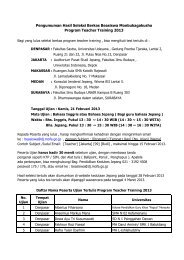9700_y16_sy
9700_y16_sy
9700_y16_sy
Create successful ePaper yourself
Turn your PDF publications into a flip-book with our unique Google optimized e-Paper software.
Cambridge International AS and A Level Biology <strong>9700</strong> <strong>sy</strong>llabus Syllabus content<br />
5 The mitotic cell cycle<br />
When body cells reach a certain size they divide into two. Nuclear division occurs first, followed by<br />
division of the cytoplasm. The mitotic cell cycle of eukaryotes involves DNA replication followed by<br />
nuclear division. This ensures the genetic uniformity of all daughter cells.<br />
Candidates will be expected to use the knowledge gained in this section to solve problems in familiar and<br />
unfamiliar contexts.<br />
Learning outcomes<br />
Candidates should be able to:<br />
5.1 Replication and division of<br />
nuclei and cells<br />
During the mitotic cell cycle,<br />
DNA is replicated and passed<br />
to daughter cells.<br />
Stem cells in bone marrow<br />
and the skin continually<br />
divide by mitosis to provide a<br />
continuous supply of cells that<br />
differentiate into blood and<br />
skin cells.<br />
a) describe the structure of a chromosome, limited to DNA,<br />
histone proteins, chromatids, centromere and telomeres<br />
b) explain the importance of mitosis in the production of<br />
genetically identical cells, growth, cell replacement, repair of<br />
tissues and asexual reproduction<br />
c) outline the cell cycle, including interphase (growth and DNA<br />
replication), mitosis and cytokinesis<br />
d) outline the significance of telomeres in permitting continued<br />
replication and preventing the loss of genes<br />
e) outline the significance of mitosis in cell replacement and<br />
tissue repair by stem cells and state that uncontrolled cell<br />
division can result in the formation of a tumour<br />
5.2 Chromosome behaviour in<br />
mitosis<br />
The events that occur during<br />
mitosis can be followed by<br />
using a light microscope.<br />
a) describe, with the aid of photomicrographs and diagrams, the<br />
behaviour of chromosomes in plant and animal cells during the<br />
mitotic cell cycle and the associated behaviour of the nuclear<br />
envelope, cell surface membrane and the spindle (names of<br />
the main stages of mitosis are expected)<br />
b) observe and draw the mitotic stages visible in temporary root<br />
tip squash preparations and in prepared slides of root tips of<br />
species such as those of Vicia faba and Allium cepa<br />
Back to contents page<br />
www.cie.org.uk/alevel<br />
23





